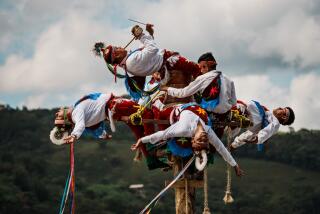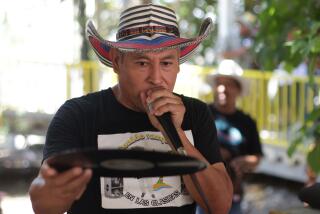Altitude Illness : ‘Soroche’: It Takes Your Breath Away
- Share via
LA PAZ, Bolivia — When Pope John Paul II came to Bolivia earlier this month, he knew enough about the high altitude here to avoid exertion and to sip soothing infusions of coca tea. If the Pope suffered from soroche, the altitude illness that overcomes many visitors to La Paz, it was a light case. But Father Jose de Acosta, another traveling priest, was not so fortunate.
After some hard riding through similar Andean heights, Acosta complained of severe discomfort, including “so much retching and vomiting that I thought I would give up my soul.” In a book published near the end of the 16th Century, the Spanish Jesuit continued:
“All of our companions, who numbered 14 or 15, were very fatigued. Some asked for confession along the way, thinking they really were dying. . . . I saw another who threw himself to the ground and screamed with the rabid pain.”
Anguished Beasts
Acosta added that “it is not only men who feel that anguish, but also beasts, which sometimes become so subdued that no spur is enough to move them.”
Attracted by gold and silver, the Spanish soon adapted to the lofty elevations. Their settlements grew. And La Paz, at 12,000 feet above sea level, became the highest national seat of government in the world. Today, the metropolitan area has a growing population of 1.5 million.
In its rarefied air, La Paz is an exotic city of glinting sunlight and sharp shadows, bustling with the multicolored skirts of Andean Indians and the Western-style suits of urban office workers. Its adobe huts with zinc roofs and its high-rise office buildings of concrete and glass cling to a wide, steep canyon at the edge of a high plain known as the altiplano.
‘Subtle Air’
For newcomers not adapted to what Father Acosta called the “subtle and delicate” air, the altitude may bring on dizziness, headaches, stomach problems, shortness of breath, muscle cramps, weakness and other discomforts, sometimes in debilitating combinations. These are well-known symptoms of soroche, which means “exhaustion” or “prostration” in the language of Bolivia’s Aymara Indians.
But the altitude is less a problem than a point of pride for most natives of La Paz, known as pacenos. La Paz Golf Club boasts the world’s highest grass course of 18 holes, where the ball is said to soar for extra yardage because of reduced air resistance. And rising above the city not far away is the world’s highest ski slope, Chacaltaya, with snows that never melt away. The Chacaltaya tow takes skiers to a breathtaking level of 17,000 feet, higher than any U.S. peak south of Alaska.
Another “world’s highest” is the La Paz airport, named El Alto or The High One, where John Paul II arrived in a Boeing 727 on May 9. The airport runway is nearly 2 1/2 miles long, and for good reason. To gather speed for takeoff in the thin air here, a 727 needs twice as much runway as it would at sea level, airport officials say.
‘A Big Experience’
Pilots lifting off at El Alto for the first time are captivated, said Hans Beckmann, a 727 pilot with Lloyd Aereo Boliviano airline. “It is like a big experience for everyone,” he said.
Although the Pope did not need medical aid when he landed at the 13,000-foot-high airport above the city, many visitors do. An airport clinic has a doctor and bottled oxygen available at all hours.
On a busy day about a week before the Pope’s arrival, the clinic treated 25 people. Airport physician Rolando Mercado said most were foreigners suffering from hypoxia, a condition resulting from a decreased supply of oxygen to body tissues.
Because the atmosphere is thinner here than at sea level, Mercado explained, oxygen pressure is considerably lower. “The low oxygen pressure makes the arriving passenger feel a lack of oxygen in his body,” he said. “At the same time, he may be under stress from traveling, and this stress makes the body consume more oxygen.”
‘Half Psychological’
He added: “There is also a psychological factor. Half of this problem of hypoxia is psychological.”
Psychological or not, soroche is real. A few people with heart ailments have died after arriving in La Paz, Mercado said, and others have had to be hospitalized. Heart attacks have hit about four arriving travelers so far this year, he said.
For less serious cases, Mercado offers a pill to raise blood pressure and another to open lung passages and reinforce the heart. He also recommends a mysterious remedy named “Soroche Pills,” concocted from unspecified ingredients by a La Paz pharmacy.
“With all of these things, in 10 or 15 minutes the patient feels very well, his color returns, and he begins to breathe normally,” the doctor said.
Coca Tea
Mate de coca, or coca tea, which the Pope drank while here, is made from the same leaves that are the raw ingredient of cocaine. Mercado said the tea will act as an analgesic to reduce the secretion of stomach acid, which can cause gastritis and draw oxygen from other parts of the body where it is urgently needed. Coca tea contains such a minute amount of cocaine that it has little other effect as a drug, he said, although it can have a soothing psychological effect.
Some hotels offer the tea to guests as soon as they arrive. Victor Simpson, an Associated Press correspondent who traveled to Bolivia on the papal tour, said the tea helped.
“When I first got off the plane, my knees were shaking,” Simpson said. “I mean shaking. And until I got down to La Paz and had some mate de coca, I really wasn’t feeling well.”
Sometimes, no amount of medication will cure soroche. Not long ago, an American intellectual who came to La Paz for a series of lectures and meetings called the U.S. Embassy for help in the middle of his first night here.
First Flight Home
“We had to put him in a clinic and cancel his whole program,” said Mark Jacobs, an embassy official. “He left on the first flight to the United States.”
On the other hand, some foreign athletes come to the Bolivian highlands to practice, finding that the oxygen-poor air helps build up their stamina. Miguel Velarde, sports editor for the La Paz newspaper Hoy, said the two Mexicans who won gold medals in the 20-kilometer and 50-kilometer walk races at the 1984 Olympic Games in Los Angeles had spent several weeks training near La Paz.
Bicycle racers come to La Paz to break sprint records, taking advantage of the low air resistance. Visiting soccer teams, however, sometimes have problems with soroche.
Velarde said that until a few years ago, some soccer teams came many weeks before they were scheduled to play, hoping that the time would help their players adapt to the altitude. But now, he said, most visiting teams try to arrive just before their games, hoping to play before they are weakened by the altitude.
Gradual Change
Many lowland teams on their way to play in La Paz stop for a few days at Cochabamba, elevation 8,400 feet, for a more gradual change of elevation. “It seems to work best,” Velarde said.
Visiting boxers are advised by altitude-wise trainers that they must try to win their fight in the first two rounds. “Starting with the third round,” he said, “they will start to feel the effects of the altitude.”
At the Bolivian Institute of High Altitude Biology, researchers say people living in La Paz develop concentrations of red blood cells up to 20% higher than the norm at sea level. The extra red cells are useful for carrying oxygen to muscles and nerves.
And when someone comes to La Paz from sea level, the concentration of carbon dioxide in his blood drops by as much as one-fourth, said Dr. Enrique Vargas, the institute’s director. Carbon dioxide is needed to propel oxygen through the tiny capillaries that feed body tissue, especially brain cells.
Double Disadvantage
So the lowlander in La Paz may feel a double disadvantage in keeping his body supplied with enough oxygen, Vargas said. There may be a shortness of breath and a natural reaction of concern, a faster heartbeat, more rapid breathing, then hyperventilation.
“Exaggerated hyperventilation does not do any good,” Vargas said. “On the contrary, it is the cause of the problem.”
Hyperventilation may produce “carbon dioxide washout,” a reduction of the gas in the bloodstream to as little as one-third the normal amount, further limiting the circulation of oxygen through the capillaries, Vargas said.
At that point, soroche sets in: the throbbing head, pallid skin, nausea, rubbery legs and other symptoms that so many visitors have suffered.
Eat Lightly
Vargas and other doctors say the worst of altitude sickness can be avoided. First, they say, stay calm and don’t hyperventilate. Take it easy after arrival, avoiding all exertion, even more than a little walking. Eat lightly, avoiding peppery food and fats. Drink plenty of liquids but little or no alcohol. Smoking is not recommended for the first 48 hours.
In addition to the disadvantages of high altitude for people new to it, Vargas’ institute has learned much about advantages for those who are used to it. For example, he said, La Paz residents live with less strain on their cardiovascular systems than Bolivians at lower elevations.
“We have a smaller heart, and we have less arterial pressure,” he said. “There are fewer heart attacks among our people--that has been proven.”
Troublesome Autos
Despite such advantages, living at 12,000 feet has its problems for anyone. Many foods must be cooked longer, since the boiling point of water is lower than at sea level. Photographers must use special filters to tone down the sharp contrasts in light. Automobiles have less power at 12,000 feet, so La Paz motorists must be careful with frequent stops and starts when steep cobblestone streets are clogged with traffic.
“It’s hard to get started, and the clutch plate can be ruined,” said taxi driver Americo Rios. To compensate, most cars here have special low-ratio differential gears.
There are myths about the altitude, too. One spread by early Spanish chronicles said settlers at Potosi, a mining center at 13,350 feet, were out of sorts because the altitude made them impotent.
“That is a legend I never believed,” said Bolivian historian Alberto Crespo Rodas. “Later there were many foreigners in Potosi, and they never had any problem having children.”
Many Myths
Such myths may have arisen partly from a Spanish fondness for entertaining stories, as Crespo Rodas contends, and partly from ignorance. In the 16th Century, Father Acosta and his fellow explorers had little knowledge of what caused the great discomfort they experienced in the high Andes.
“There is no doubt that the cause of this strange indisposition and alteration is the wind or the air that reigns there,” the priest wrote, “because the remedy (and it is a very big one) that they find is to cover their ears, nose and mouth as much as they can, and bundle up with clothes, especially the stomach, because the air is so subtle and penetrating that it goes through the innards.”
More to Read
Sign up for Essential California
The most important California stories and recommendations in your inbox every morning.
You may occasionally receive promotional content from the Los Angeles Times.













